Prepare to be amazed as you make the juiciest, most mouthwatering Authentic Texas Smoked Brisket recipe in your own backyard with a wood or pellet smoker. Seasoned with a simple dry rub, this is the BEST smoked brisket – perfect for your next outdoor BBQ!
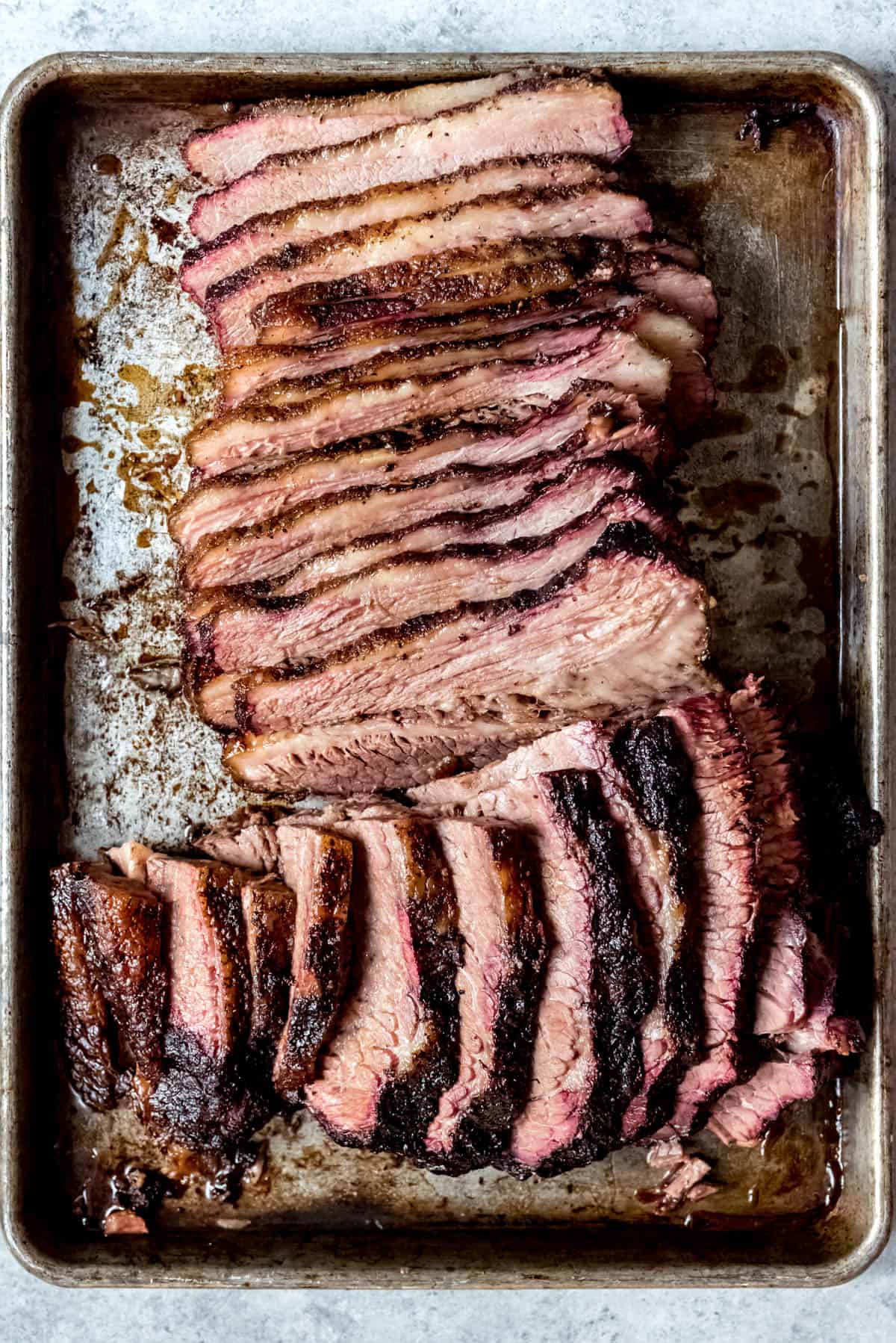
We love smoked meats and use our smoker all the time! For more smoking recipes, check out our Brined & Smoked Turkey, this Smoked Spatchcock Chicken, and this classic Smoked Pulled Pork. We have also cooked an Entire Meal on the Smoker and it was so delicious!
Table of Contents
- House of Nash MEATS
- What is Texas Barbecue?
- Why We Love This Recipe
- What You’ll Need
- Tools Needed for This Texas Smoked Brisket Recipe
- How to Smoke a Brisket in a Smoker
- Recipe FAQs
- How do I slice brisket for serving?
- Tips for Success
- Simple Smoked Brisket Rub Tips
- Substitutions and Variations
- What is Served with Texas Barbecue?
- More Barbecue Recipes You’ll Love
- Texas Smoked Brisket Recipe
- More States I Have Visited in my American Eats Series
When it comes to BBQ, I’ll admit that smoked brisket is my very favorite. I grew up eating my mom’s Slow Roasted Oven BBQ Beef Brisket that she would bake low and slow in the oven for hours. If you don’t have a wood smoker or a pellet grill this is a great way to make brisket, but it is very different from true Texas smoked brisket.
If you haven’t tried real, authentic Smoked Texas Brisket, then you’re missing out! Authentic brisket will have a dark, almost black, bark on the outside and a pink smoke ring when you slice it. It’ll be served on pink butcher paper sans sauce!
Don’t be fooled by the short ingredient list in this smoked brisket recipe. All you need to create authentic Texas-style smoked brisket is a super simple rub and the smoke from the wood. That’s it. No marinade. No wet mop sauce. A perfect brisket is made with just wood smoke and a simple spice mixture. This is how you would get brisket at a famous central Texas BBQ joint in Austin like Franklin Barbecue or Pecan Lodge.
Serve your juicy brisket with Macaroni & Cheese, Cornbread, Smoky BBQ Baked Beans, Homemade Creamy Coleslaw, and Carolina Mustard BBQ Sauce on the side and a Peach Cobbler sweet treat for a BBQ feat that would make any Texan proud!
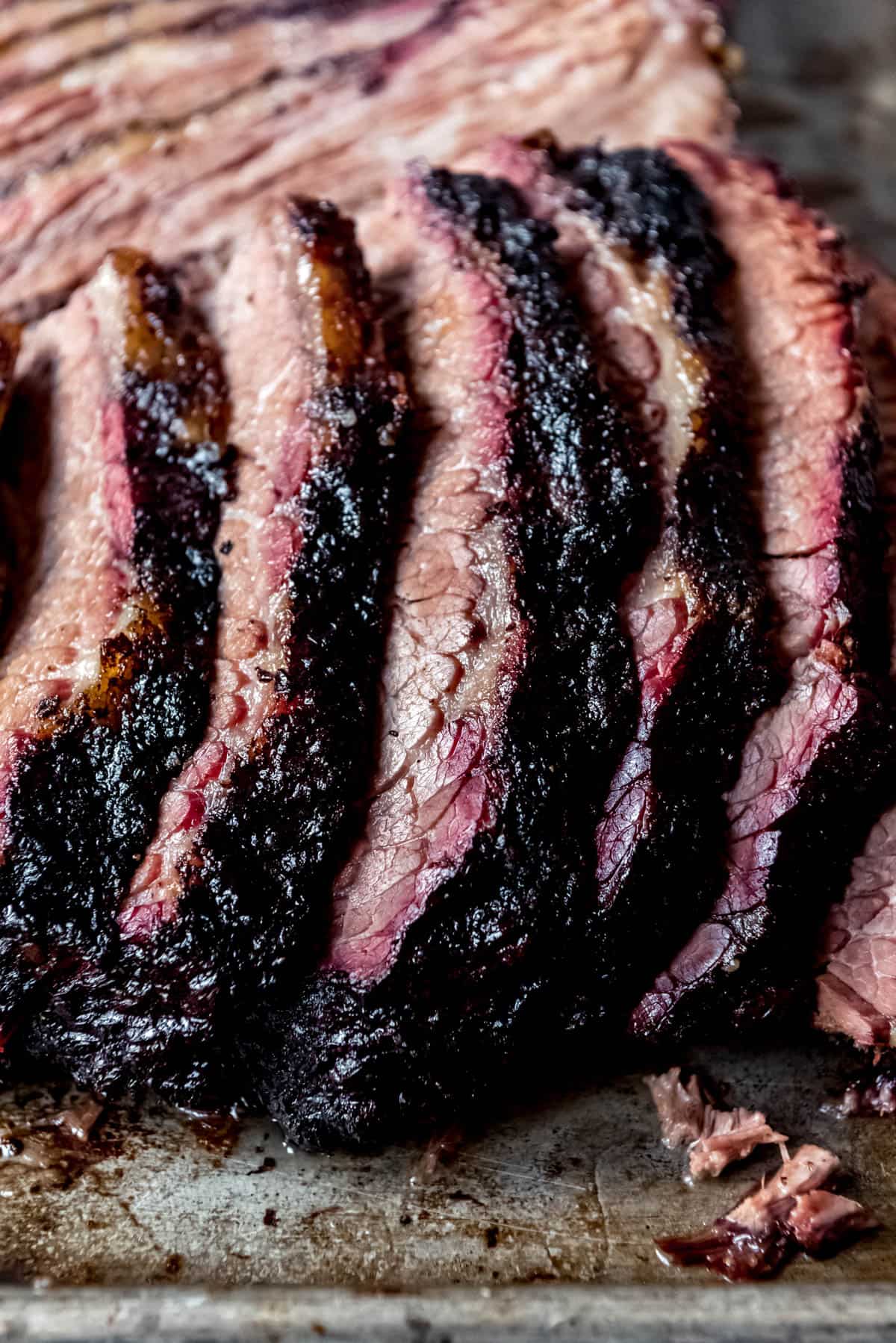
House of Nash MEATS
Paul and I love smoking meats on our Traeger smoker. A while back, Paul had a great idea and recommended I do a series devoted to the meats we smoke, called House of Nash MEATS!
This Texas smoked brisket recipe is part of the series, and it also includes this Hot Smoked Salmon, my Brown Sugar & Honey Baby Back Ribs, this classic Smoked Pulled Pork, and these amazing Smoked Pork Belly Burnt Ends!
What is Texas Barbecue?
Barbecue is a method of cooking that uses a closed lid and indirect heat to cook the meat. Don’t confuse barbecue with grilling, which uses direct heat where the meat is cooked right over the flame or heat source. Grilling has a quicker cooking time while barbecue takes a lot longer, even 12 hours or more, depending on the cut of meat.
There are four major types of BBQ in the United States: Memphis barbecue, Kansas City barbecue, Carolina barbecue, and Texas barbecue. Each type of barbecue is known for its own preference for the type of meat, the spices it uses, the fuel source, and the fixings that go along with it.
We always seek out the best Texas barbecue when we visit Texas and load up on smoked brisket, beef ribs, and smoked sausage. Cooper’s Old Time Pit Bar-B-Que is our favorite, but one of these days we are going to brave the line and try Franklin Barbecue!
When it comes to meat, Texas barbecue is all about beef. Beef brisket and beef ribs are the main stars of Texas barbecue, but you will also find some amazing sausage, chicken, turkey, and even pork chops, pork loin, and pulled pork at many Texas barbecue joints.
Texas barbecue has a wood-burning barbecue tradition, although the type of wood used will differ depending on whether you are in Central, South, East, or West Texas.
Central Texas uses oak and pecan wood, with dry rubs and meat smoked at low heat. Central Texas barbecue was highly influenced by Czech and German settlers who owned butcher shops and started offering smoked meat to customers.
West Texas is known for burning mesquite at higher temperatures, and its barbecue traditions hark back to days of cattle drives and cowboys.
East Texas and South Texas both emphasize barbecue sauce. South Texas barbecue has a heavy Mexican influence (it’s known for its barbacoa) and East Texas has more of a saucy, chopped barbecue style that developed with a significant influence from former slaves who settled the region after being emancipated from slavery.
To make this smoked brisket recipe, we were heavily influenced by Aaron Franklin’s book, Franklin Barbecue, along with a couple of other smoking cookbooks that we have in our collection. Aaron Franklin is basically the reigning King of Brisket and Barbecue in Texas. People will wait for 3 to 4 hours in line just to get some of the brisket smoked by him and his team, which often runs out! He is located in Austin, Texas, which makes his style very typical of Central Texas barbecue.
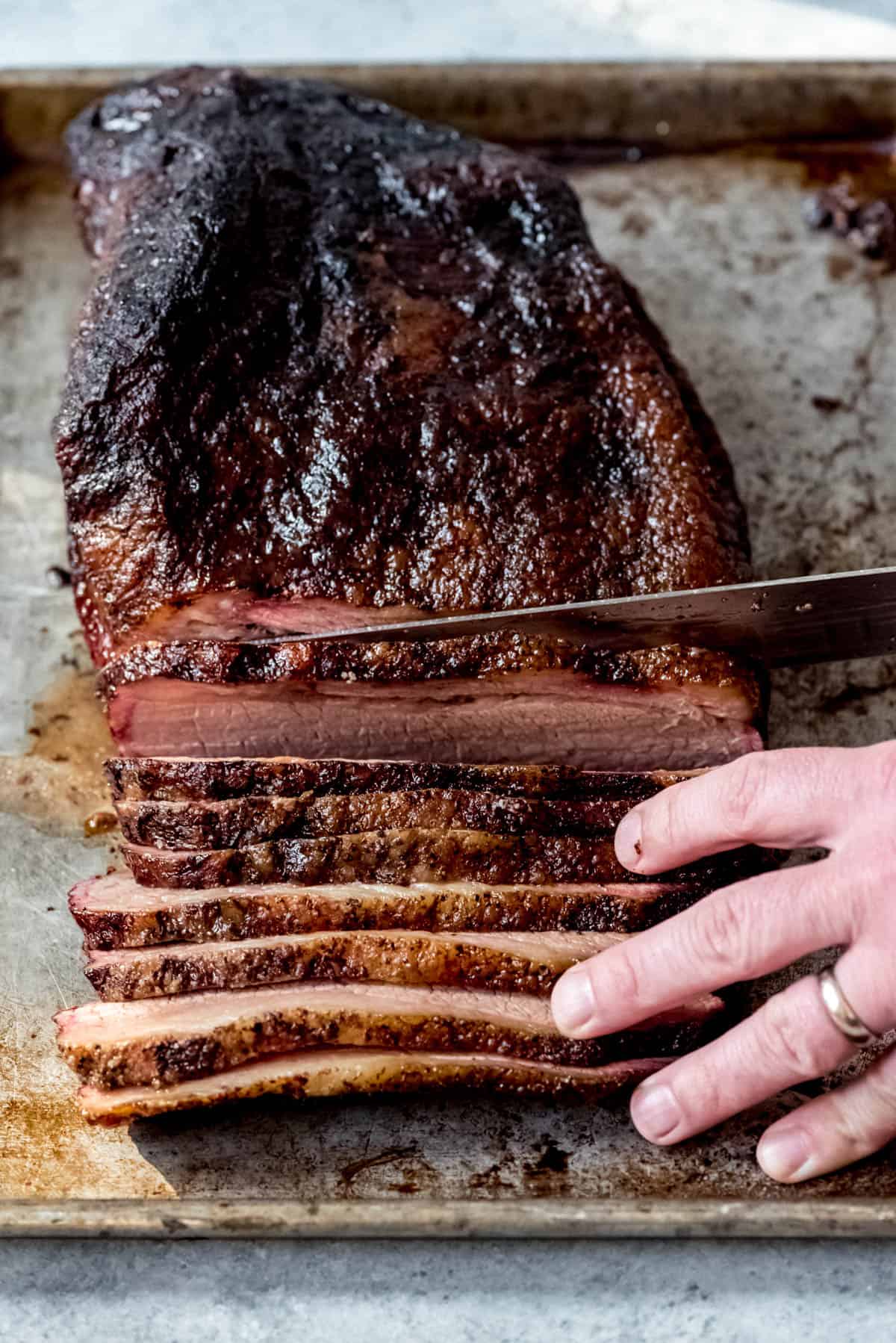
Why We Love This Recipe
- You only need 4 ingredients to make the best brisket you’ve ever had!
- Feeds a large crowd, it’s perfect for special occasions and large family gatherings.
- Customize the rub with different flavors to enjoy it any way you like.
- Detailed guide with everything you need to know to become a master at smoking brisket!
What You’ll Need
Scroll down to the recipe card below this post for ingredient quantities and full instructions.
- Beef Brisket – You’ll need 12-14 pounds of whole packer brisket.
- Black Pepper – Ground black pepper is best to add a strong peppery flavor.
- Kosher Salt – Kosher salt is best for elevating all the different flavors in this juicy meat.
- Garlic – Use granulated garlic for a strong aromatic flavor for your brisket. You can use freshly minced garlic, but the amount needed may vary.
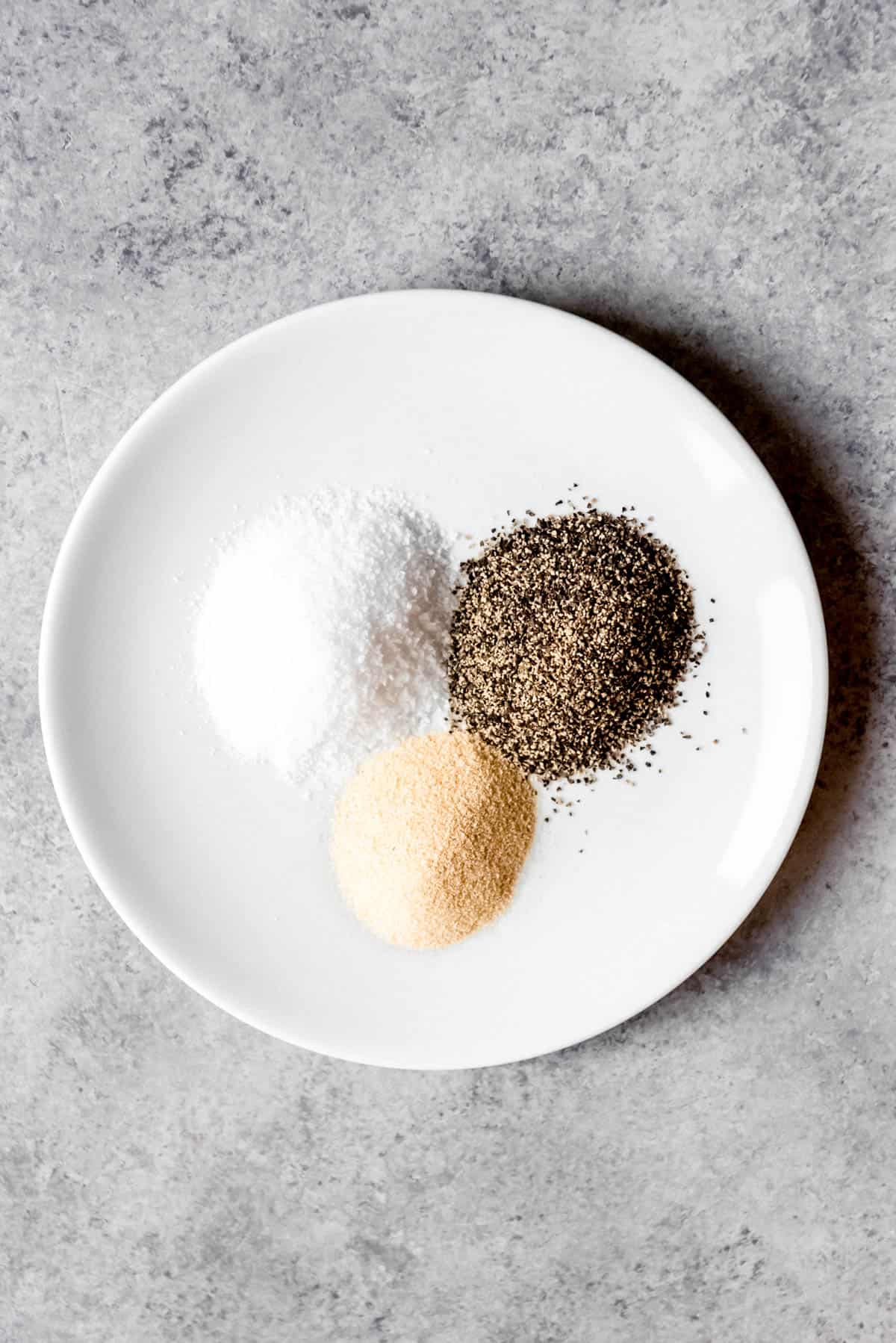
Tools Needed for This Texas Smoked Brisket Recipe
- Smoker: We have a little Traeger and it works great, but any smoker will work.
- Wood or Pellets: We like using the Traeger Texas blend or oak pellets, with hickory being our next choice.
- Digital Meat Thermometer (affiliate link): We have a few that we use because they are indispensable when smoking meat. This is our favorite.
- Pink Butcher/Peach Paper or heavy-duty foil
- Sharp knife for trimming
- Sharp knife for slicing
- Cutting boards and sheet pans for preparing the brisket
How to Smoke a Brisket in a Smoker
Make the rub. You are just combining black pepper, kosher salt, and granulated garlic. It’s super simple, but this brisket has an amazing flavor!

Trim the fat. Next, you need to trim the fat cap to ¼-inch to ½-inch thick. We always trim our briskets to get rid of some (but definitely not all!) of the thick layer of fat called the “fat cap” on top of the brisket.
Just use a sharp knife to make horizontal cuts to slice off all but about ¼- to ½-inch of fat cap on the brisket. As the brisket smokes, the fat will melt and flavor the meat, making it extra tender and juicy.
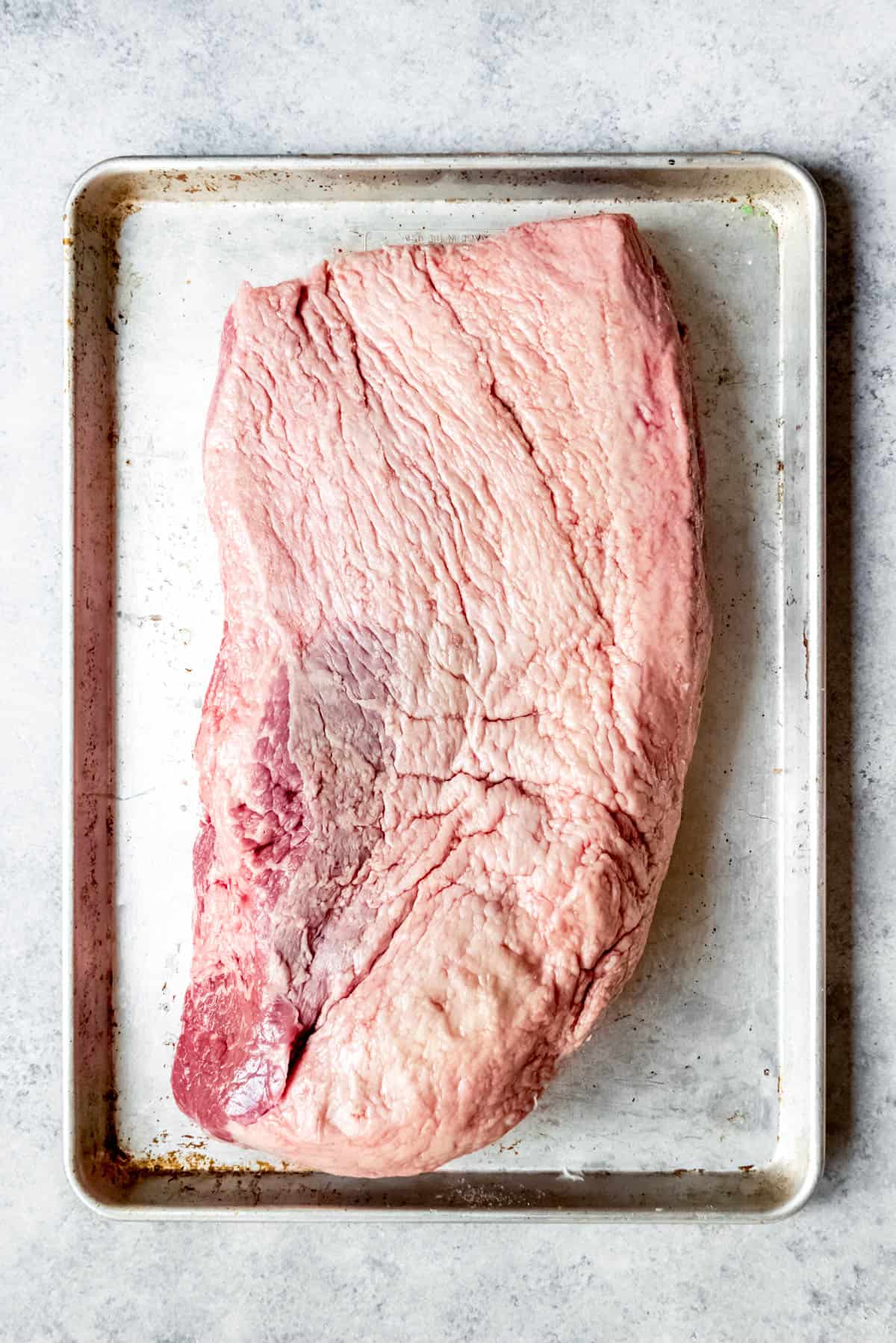

On the other side of the brisket, it’s usually a lot cleaner and you can see more of the meat. But there is still fat there that you will want to trim away.
There is usually a big hunk of fat right where the point (the thick part) and the flat (the thinner part) meet. This part can also be cut off because it won’t render all the way.
Trim off any other large fatty pieces on this side. The brisket is now ready to be hit with the spice rub!
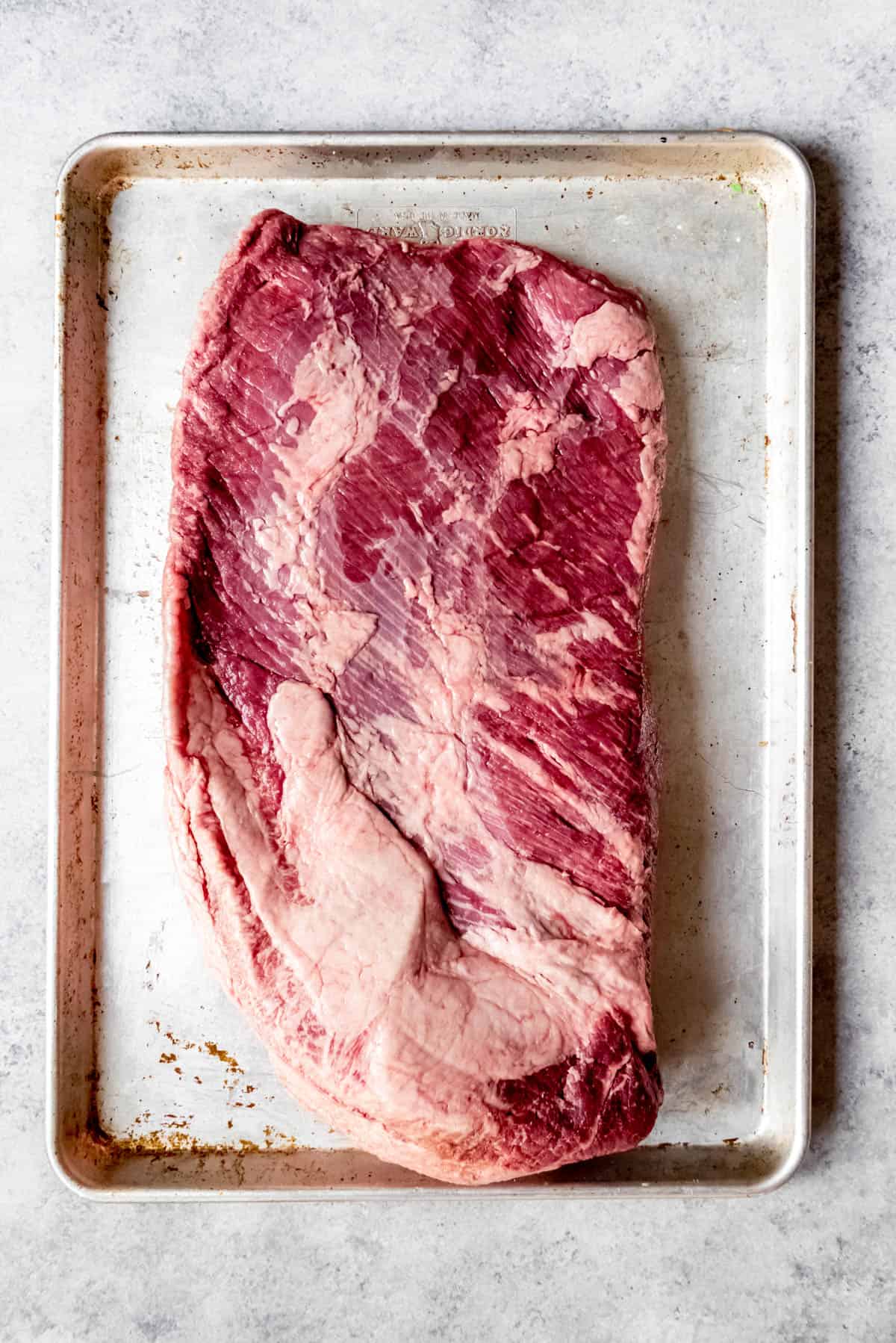
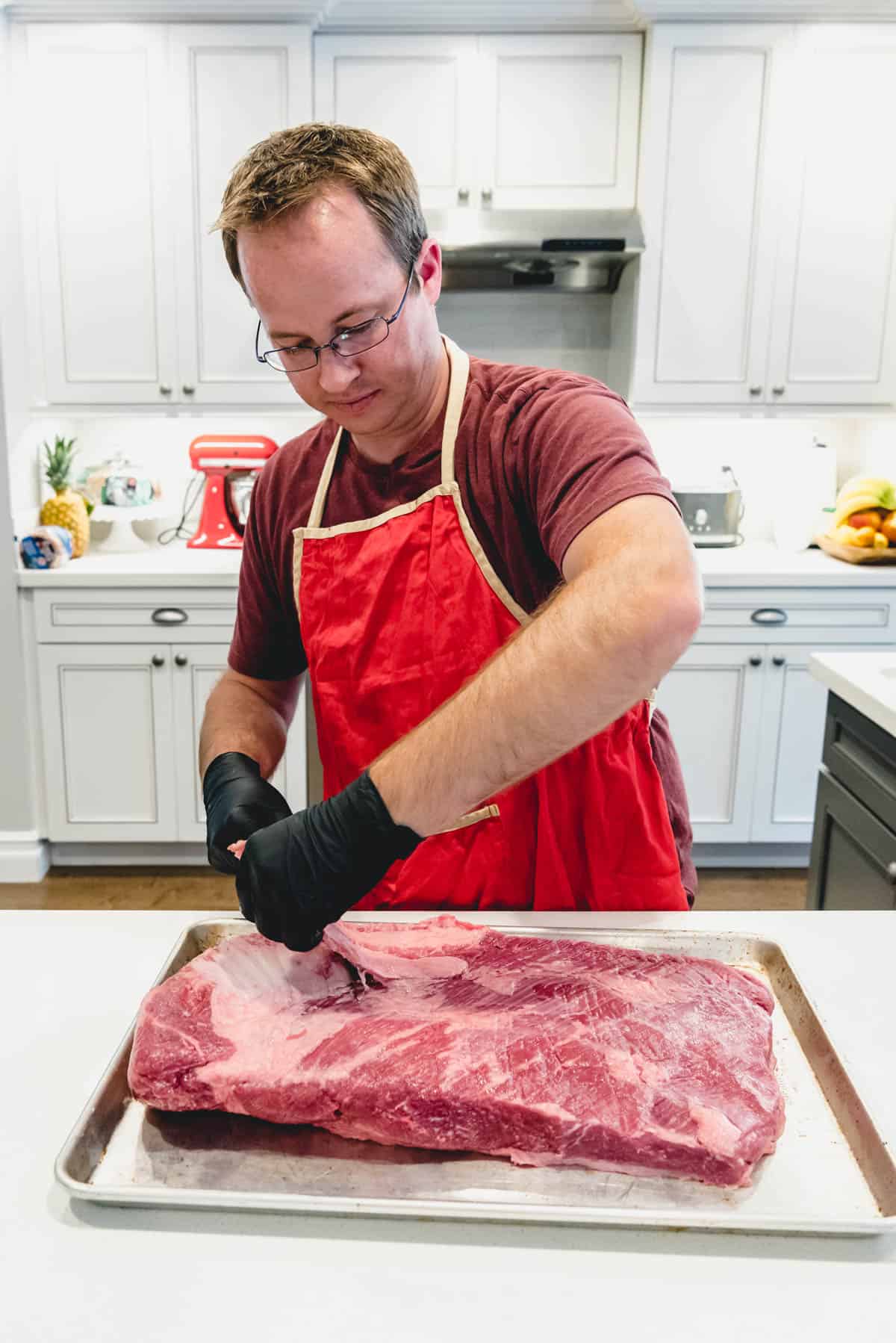
Season the brisket. Rub the brisket all over with the spice rub. We will usually do this the night before. We coat the brisket and tightly wrap it in plastic wrap and put it in the fridge overnight. Let the brisket sit at room temperature for a full hour before cooking it.
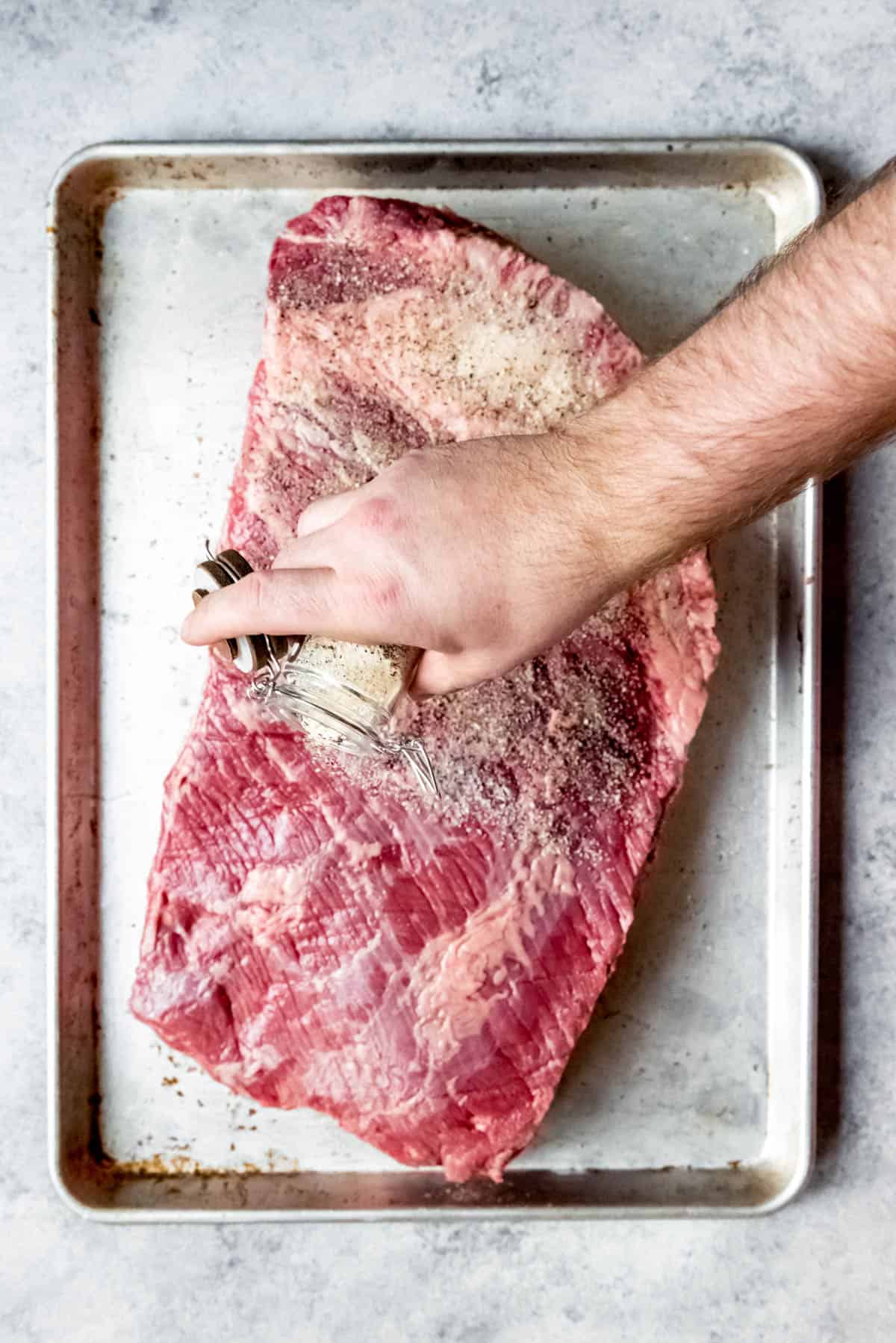
Prepare smoker. Start the smoker and get the temperature up to around 225°F to 250°F. Fill a disposable aluminum pan with water and set it on the smoker to create humidity. You will want the water pan to be full during the smoke.
Put brisket in the smoker. Place the brisket on the smoker, with the fat side up, and close the lid. Leave the lid closed and smoke the brisket for at least 3 hours. Then, start to check it every 30 minutes or so to see the nice dark color develop. Spritz the surface of the brisket with water or vinegar from a spray bottle if it starts looking dry.
Wrap brisket (optional). When the brisket has a dark color and the internal temperature of the meat reaches around 165°F to 170°F on an instant-read meat thermometer (around the 5 to 6 hour mark), you might choose to wrap your brisket in unfinished butcher paper (i.e., peach paper) or foil. There’s nothing scientific about how to do this. Simply wrap the entire brisket up with the paper or foil, and stick it back on the smoker. Wrapping the brisket (aka the “Texas Crutch”) is totally optional, and we’ve smoked brisket before without doing this.
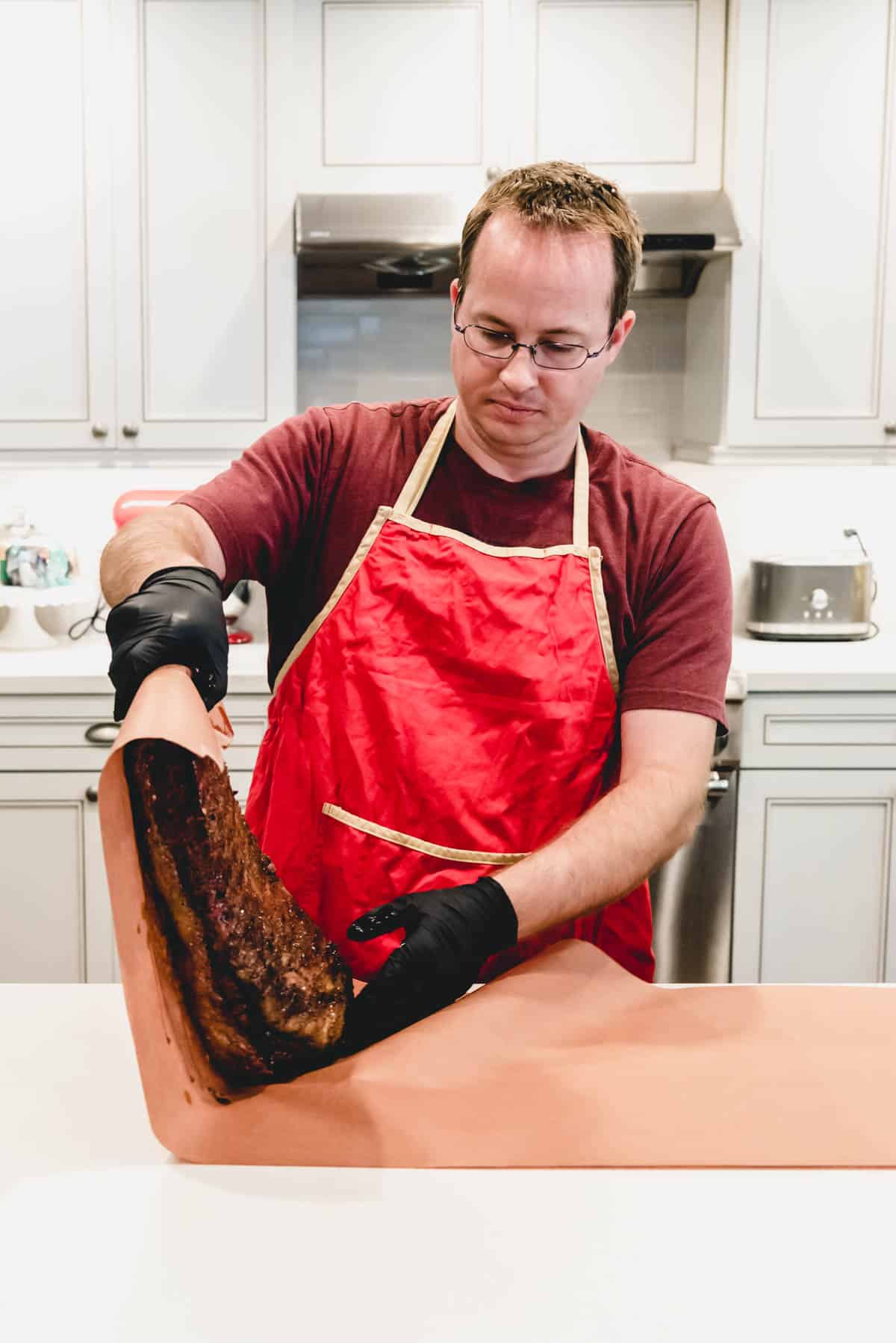
Cook. Continue to cook through the stall (a long period where the brisket temperature doesn’t go up and may even decrease). This can last hours, but it’s totally part of the process of making this truly amazing smoked brisket recipe.
Check doneness. The brisket will be done when the internal temperature reads somewhere between 200°F and 210°F. 203°F seems to be the magic number for us! Take the temperature from the middle of the flat part of the brisket (the thinner side of the brisket is called the “flat” and the thicker side is known as the “point”). According to Aaron Franklin, you can tell doneness by feeling the brisket with a thin, clean towel to see if it is soft and tender. Paul says it is done when the brisket is jiggly like jello and a temperature probe goes in and out of it like butter.
Rest and serve. Remove the wrapped brisket from the smoker and let it rest for 1 to 2 hours. The internal temperature needs to drop from 140°F to 145°F. Optional: wrap the brisket in a towel and stick it in a cooler during the rest period. Then, slice it against the grain and serve.
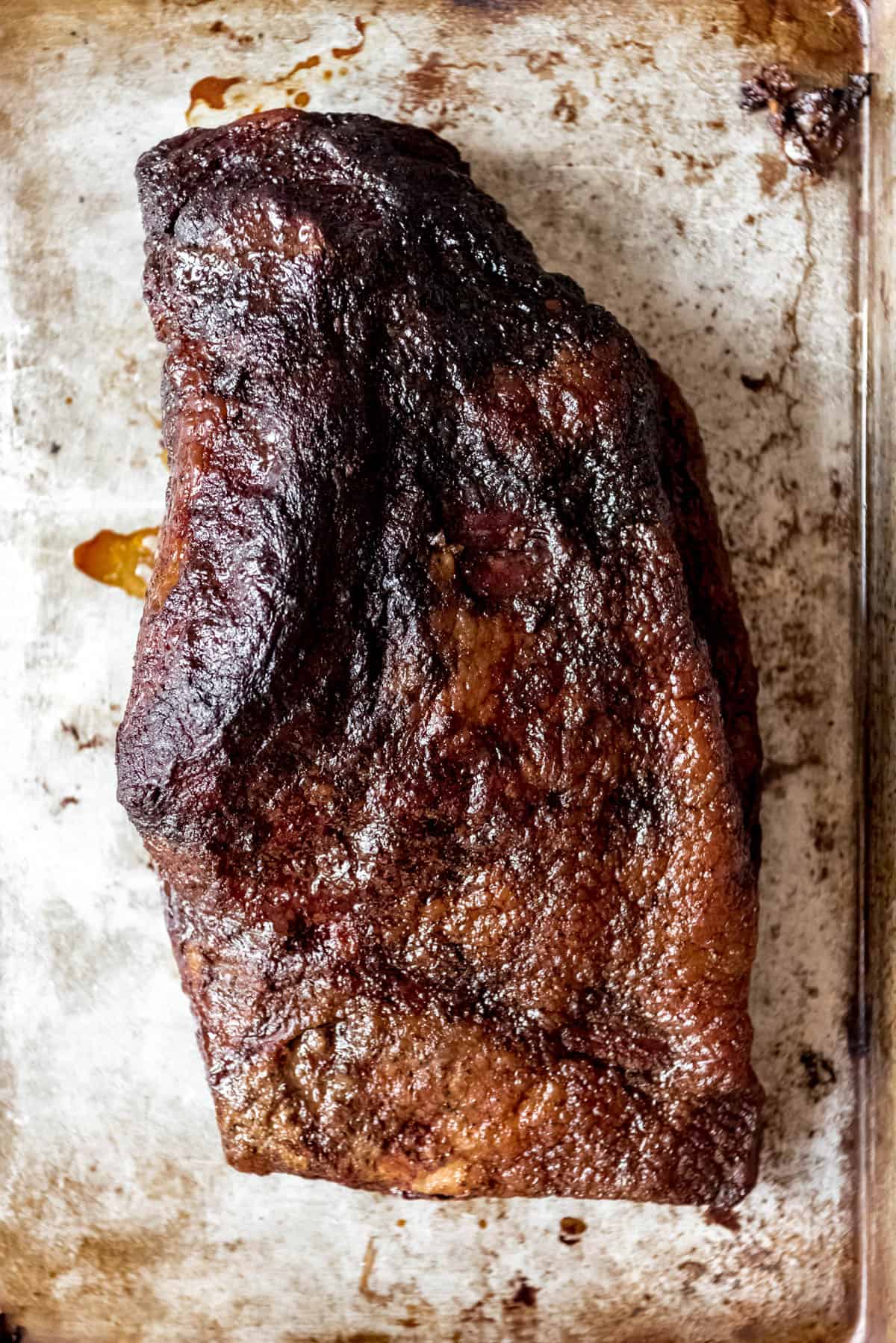
Recipe FAQs
A beef brisket that has both the point and the flat on it is known as a full packer brisket, or whole packer brisket. It will typically weigh between 12-16 lbs.
Bark on the brisket is formed by a reaction that is caused at a temperature of 235° to 250°F. If you cook your meat at a lower temperature, it will cook and become an awesome piece of meat after enough time has passed, but it won’t develop any bark.
The amount of time it will take to smoke a brisket is going to vary depending on a number of factors like temperature and size of the brisket. Another factor that will affect the time of your smoke is whether you decide to use the Texas crutch method of wrapping the brisket partway through the smoke.
Plan on around 60 minutes of smoke time per pound of meat, more or less.
So a 12-14 pound packer brisket (the untrimmed kind you can get at Costco) can take you around 12-14 hours to smoke if you decide to wrap it partway through.
You will need a huge hunk of meat but don’t be intimidated! You want to look for a packer brisket, which is a whole brisket including the point and the flat (names given to the thinner portion of the brisket and the thicker end, respectively).
Do not just get what is in the grocery store case, which is usually just the trimmed flat and a lot leaner than a packer brisket.
For this Texas smoked brisket recipe, you want the whole 12-pound packer brisket. Keep in mind that you will be trimming quite a bit of the fat yourself, so even though you start out with a 12-pound brisket you might end up with only 10 pounds of meat, and around 8 pounds of edible meat after cooking.
There seem to be quite a few debates about fat side up or fat side down and I honestly don’t know whether anyone is right! That being said, we always smoke our brisket with the fat side up with the theory that the melting fat will seep down through the rest of the brisket.
When trying to figure out how much brisket per person, plan on around ½ pound of meat for each guest. The untrimmed packer briskets we typically get from Costco typically range around 12-14 pounds. But remember from above how we are trimming fat and then more is lost during the long, slow cooking process likely leaving you with around 8-ish pounds of smoked brisket by the end?
I find that a regular size brisket typically feeds 14-16 people if they are each having just one serving and there are lots of other sides (there usually are).
Store cooked and cooled beef brisket in an airtight container or Ziploc bag in the refrigerator for up to 4 days.
Beef brisket leftovers make amazing sandwiches, salads, nachos, burritos, tacos, etc.
How do I slice brisket for serving?
Be sure to use a large, sharp knife for slicing the brisket. You want to slice against the grain for the most tender brisket ever.
Remember that the flat and the point are essentially different parts of the packer brisket. You want to slice against the grain for each piece, even if this means slicing in different directions.
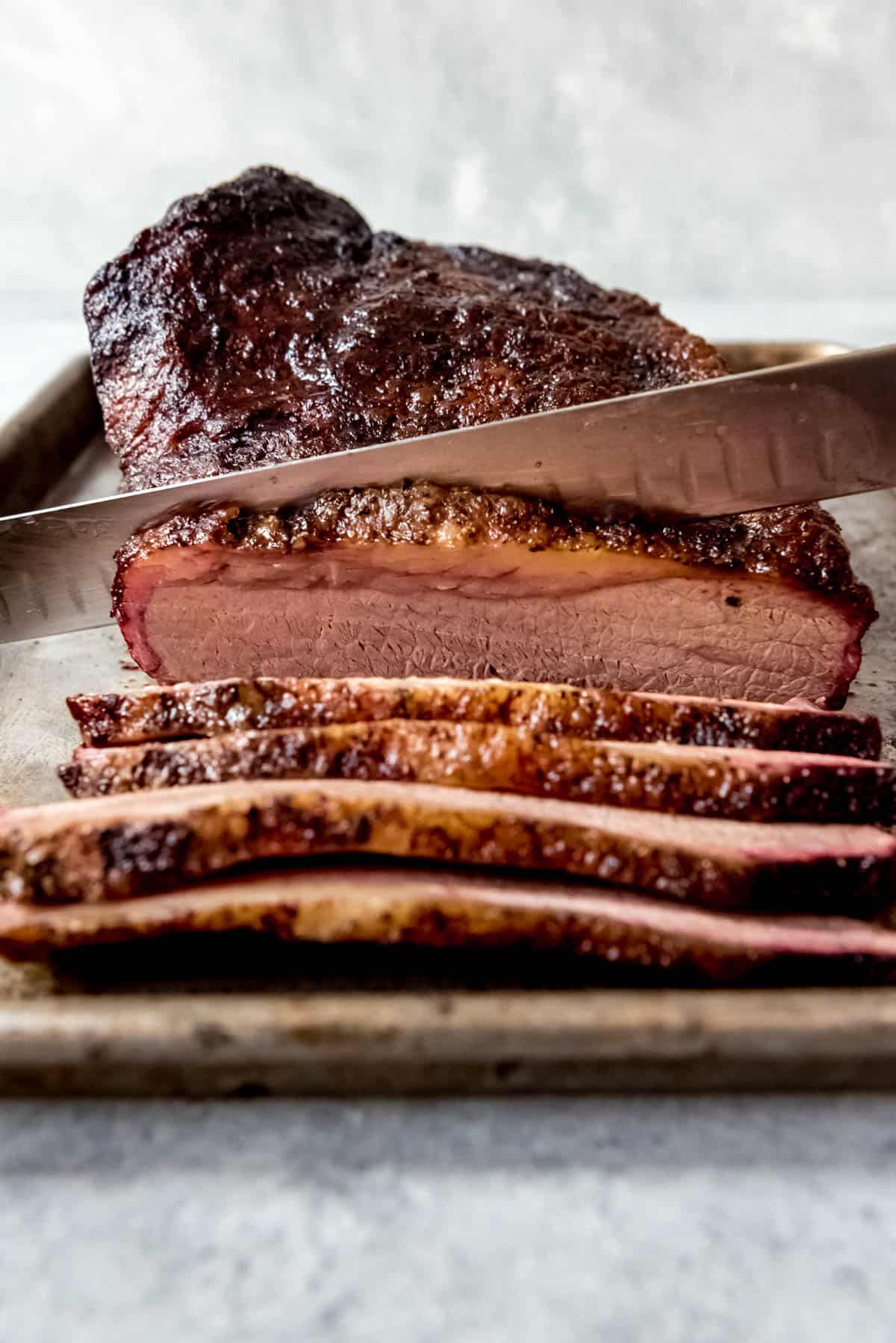
Tips for Success
The Texas Crutch
The idea behind the Texas crutch is that at some point, the brisket is going to have absorbed all the smoke it’s going to absorb, but the meat hasn’t finished cooking yet. Wrapping it, at that point, with unfinished butcher paper or foil allows the meat to finish cooking without drying out.
Some people think it’s “cheating” but we don’t have anything against using a technique that gives more consistent, easier-to-achieve results. This trick is great especially if you’re smoking a large brisket for the first time!
Wrap the brisket only once it reaches an internal temperature of 165 to 170°F on an instant-read thermometer. This is usually around the 5-hour mark. It also needs to have a nice, dark color on the outside. Some of the dark color may wash off while the meat steams in its wrapper, but that’s ok.
Choose a good wood
There are lots of different types of wood you can use for smoking meat. When it comes to Central Texas barbecue, which is what we are trying to recreate, oak is the top choice.
If you have a Traeger pellet grill, they make a Texas blend (<– affiliate link) that has a mix of oak, mesquite, and pecan woods and it gives amazing flavor as well. It’s actually the mix we used when making this brisket for this post.
Hickory is our next choice for smoking brisket (or other beef cuts like beef ribs).
I don’t think apple, cherry, or peach wood does as much for beef though since their flavor is more subtle. Those choices are better for chicken and turkey. We use Applewood for our Applewood Smoked Turkey that we make every year for Thanksgiving dinner!
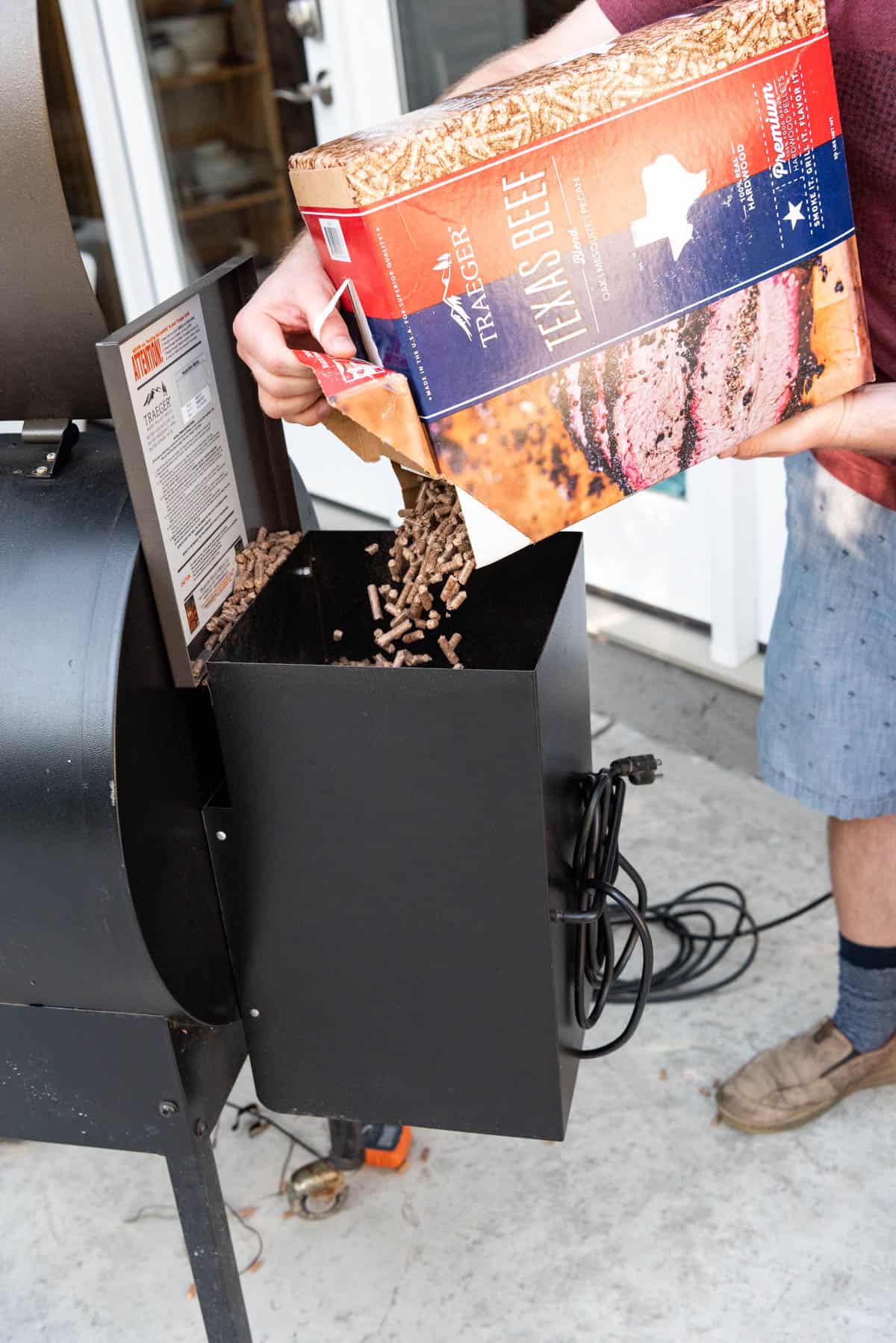
Simple Smoked Brisket Rub Tips
- The rub will help the meat form the “bark”, and it will also help the smoke adhere to the meat.
- You will want about ½ cup of rub for every 12 pounds of brisket.
- Pro Tip: Apply the rub to the brisket at least 1 hour before putting it on the smoker. Let it sit at room temperature after applying the rub.
- Season the brisket evenly with the rub. You will get more even coverage if you sprinkle the rub from a foot or two above the meat rather than doing it too close to the surface.
Substitutions and Variations
- Add flavor. You can add more seasonings, herbs, and spices to your beef brisket depending on the flavors you’d like. Onion powder is a staple seasoning to add flavor to any meat. You could also add smoked paprika, cayenne pepper, or chili powder.
- Sugar. A lot of recipes will call for brown sugar to be added to the rub for your brisket. Brown sugar can help the bark on your brisket, but it burns easily, so I tend to avoid it.
- Other meat. Use my simple rub for other cuts of beef or meat.
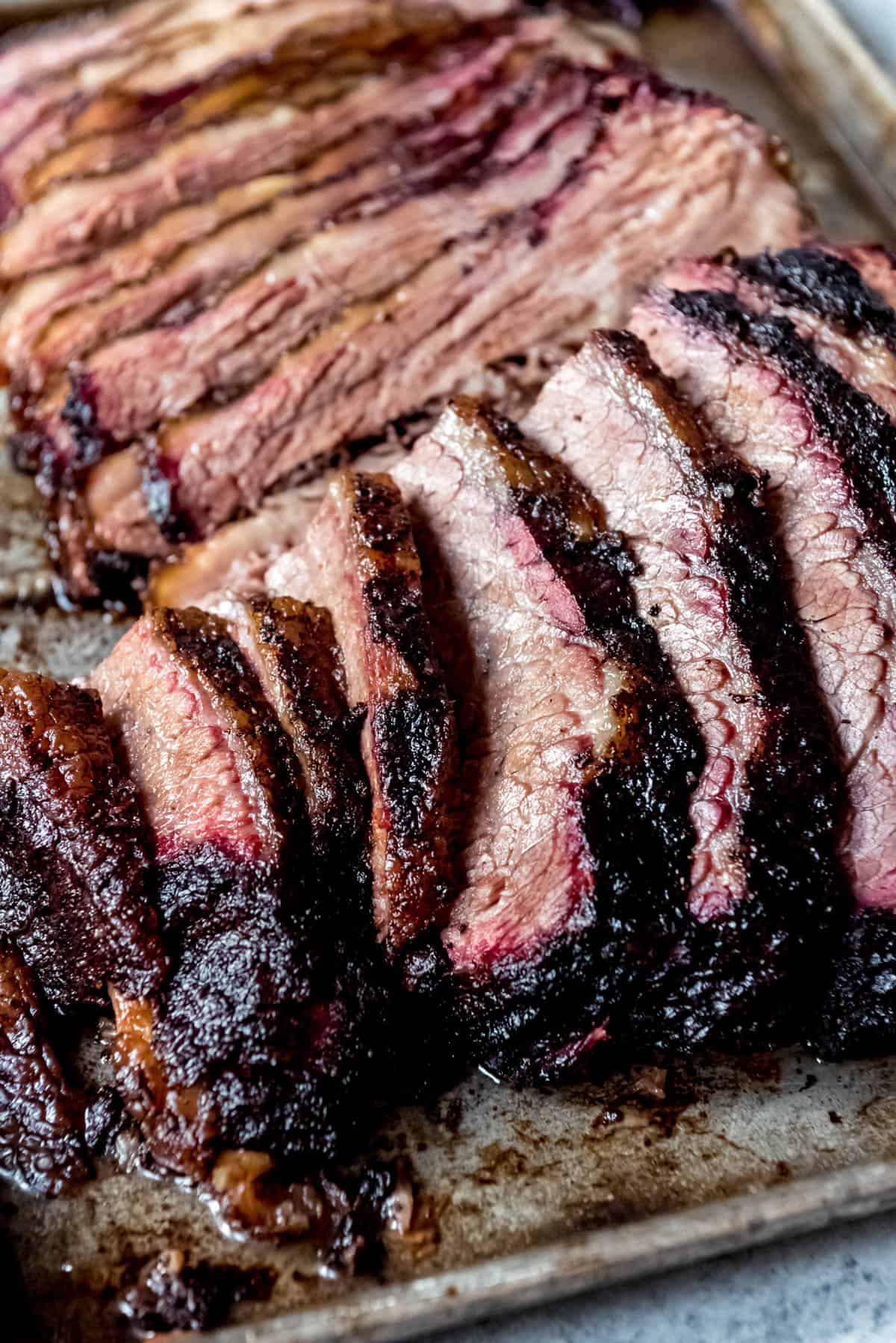
What is Served with Texas Barbecue?
Traditional Texas BBQ is served with barbecue sauce on the side (if at all), as well as slices of white bread, pickles, and pickled red onions. Popular side dishes served with real Texas barbecue include mac and cheese, corn on the cob, sliced watermelon, coleslaw, and baked beans.
And if you are planning a full Texas barbecue menu, you’ve got to have dessert! I say cobbler or a crisp is the way to go, whether it’s blackberry, peach, apple, or cherry. But you also can’t go wrong with brownies, Texas sheet cake, pie (especially blackberry or pecan), or banana pudding. Basically, all my favorite dessert choices, ever.
More Barbecue Recipes You’ll Love
- Alabama White BBQ Sauce Grilled Chicken
- Santa Maria Tri-Tip
- Korean BBQ Chicken Wings
- Rhubarb BBQ Sauce Grilled Chicken
- How to Make a Brined and Smoked Turkey
- Perfect Grilled Pork Chops with Sweet BBQ Pork Rub
Did you make this recipe?
Let me know what you thought with a comment and rating below. You can also take a picture and tag me on Instagram @houseofnasheats or share it on the Pinterest pin so I can see.
Texas Smoked Brisket
Equipment
Ingredients
- 12-14 pounds brisket, packer cut
- 1/4 cup ground black pepper
- 1/4 cup kosher salt
- 2 tablespoon granulated garlic
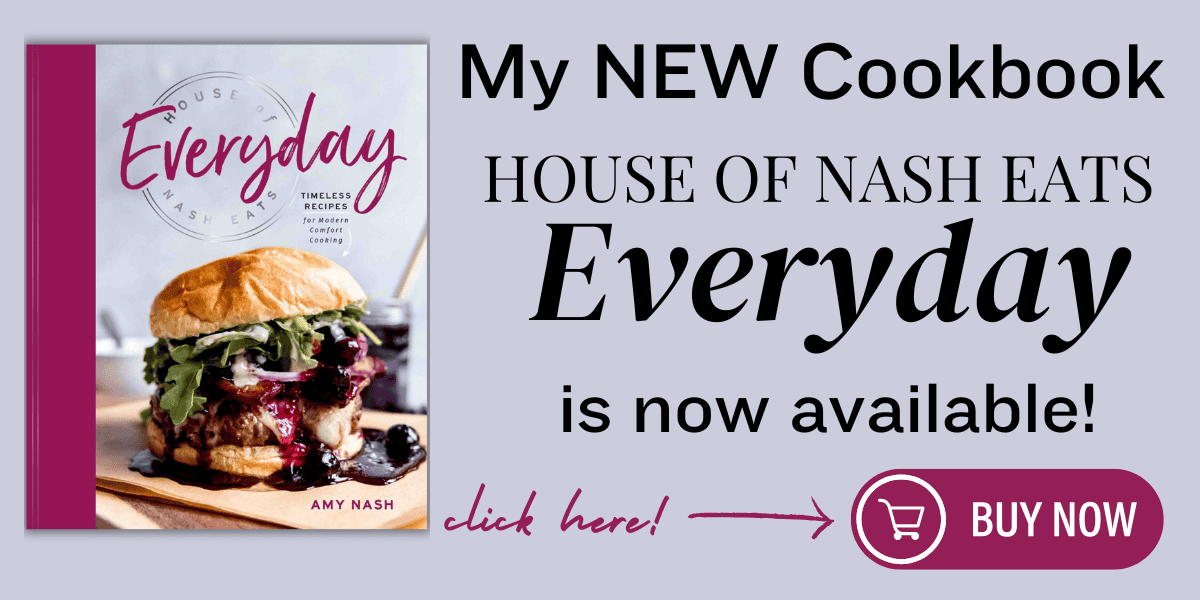
Instructions
- Combine the black pepper, kosher salt, and garlic powder.¼ cup ground black pepper, ¼ cup kosher salt, 2 tablespoon granulated garlic
- Trim the fat cap to ¼-inch to ½-inch thick, then rub the brisket all over with the spice rub. Let the brisket sit at room temperature for 1 hour.12-14 pounds brisket, packer cut
- Start the smoker and get the temperature up to around 225 to 250°F. Fill a disposable aluminum pan with water and set it on the smoker to create humidity. You will want the water pan to be full during the smoke.
- Place the brisket on the smoker fat side up and close the lid. Leave the lid closed and smoke the brisket for at least 3 hours, then start to check it every 30 minutes or so to see that a nice dark color is developing. Spritz the surface of the brisket with water or vinegar from a spray bottle if it starts looking dry.
- When the brisket has a dark color and reaches an internal temperature of around 165°F to 170°F on an instant-read meat thermometer (around the 5 to 6 hour mark), you can wrap your brisket in unfinished butcher paper, peach paper, or foil. There’s nothing scientific about this, just wrap it all up by folding the paper or foil around the meat and stick it back on the smoker.
- Continue to cook through the stall (a long period where the temperature of the brisket doesn’t go up and may even decrease a bit). This can go on for hours, but don’t worry, it’s totally part of the process of making truly amazing smoked brisket.
- The brisket will be done when the internal temperature reads somewhere between 200°F and 210°F when measured in the middle of the flat part of the brisket (203°F seems to be the magic number). You can also tell doneness by feeling the brisket with a thin, clean towel to see if it is soft and tender.
- Remove the brisket from the smoker and let it rest for 1 to 2 hours, still wrapped, until the internal temperature drops to 140°F to 145°F, then slice against the grain and serve.
Nutrition
More States I Have Visited in my American Eats Series
Alabama • Alaska • Arizona • Arkansas • California • Colorado • Connecticut • Delaware • Florida • Georgia • Hawaii • Idaho • Illinois • Indiana • Iowa • Kansas • Kentucky • Louisiana • Maine • Maryland • Massachusetts • Michigan • Minnesota • Mississippi • Missouri • Montana • Nebraska • New Jersey • New York • Oregon • Puerto Rico • South Carolina • South Dakota • Texas • Utah • Wisconsin

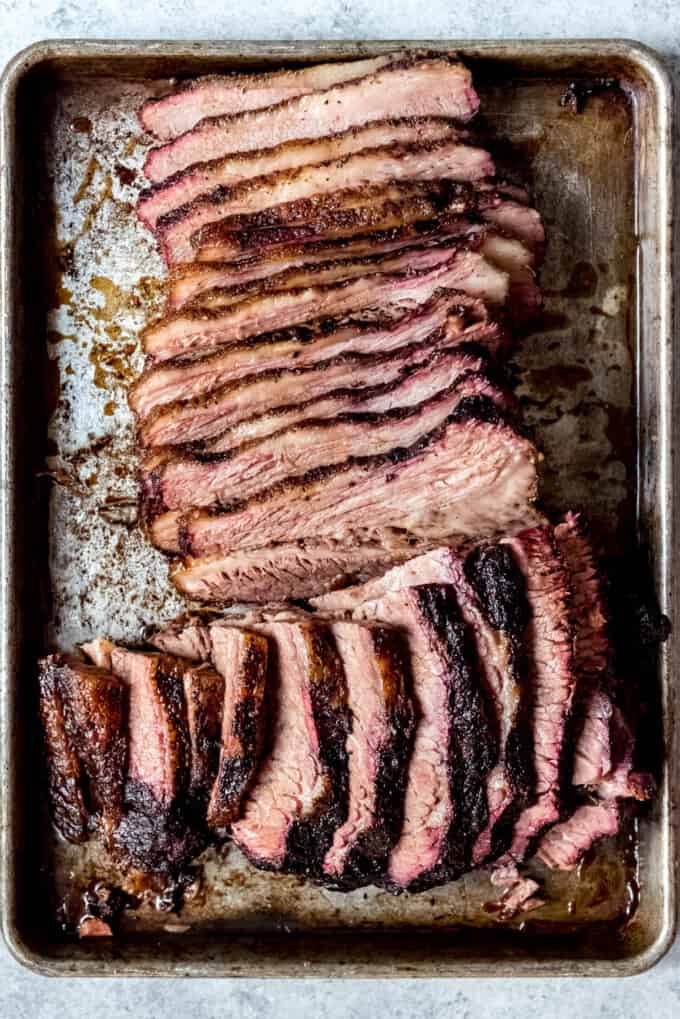
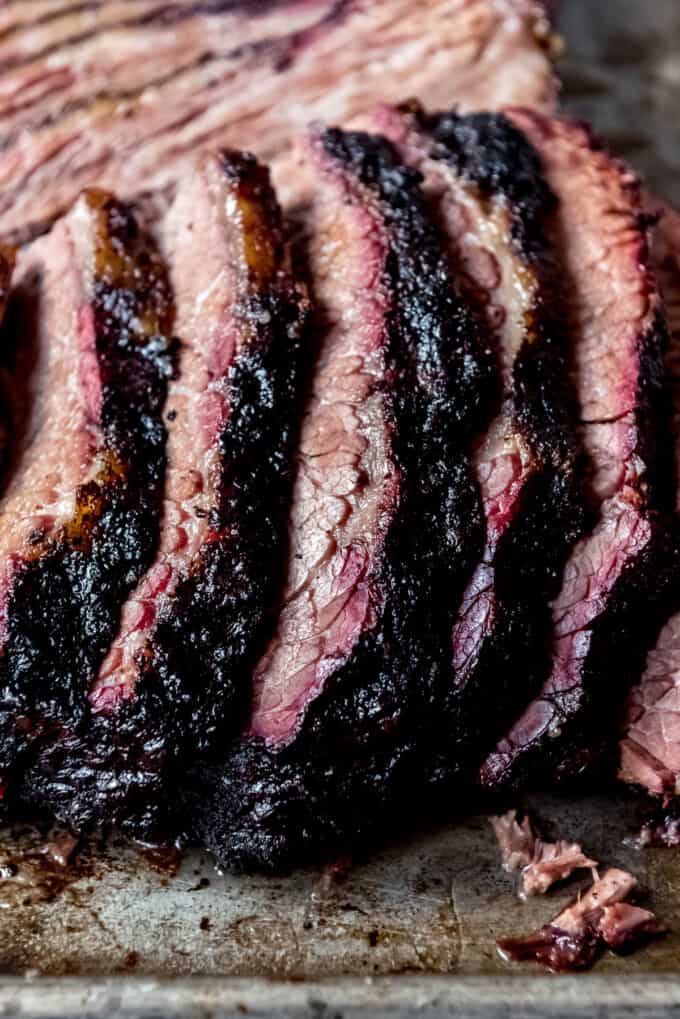
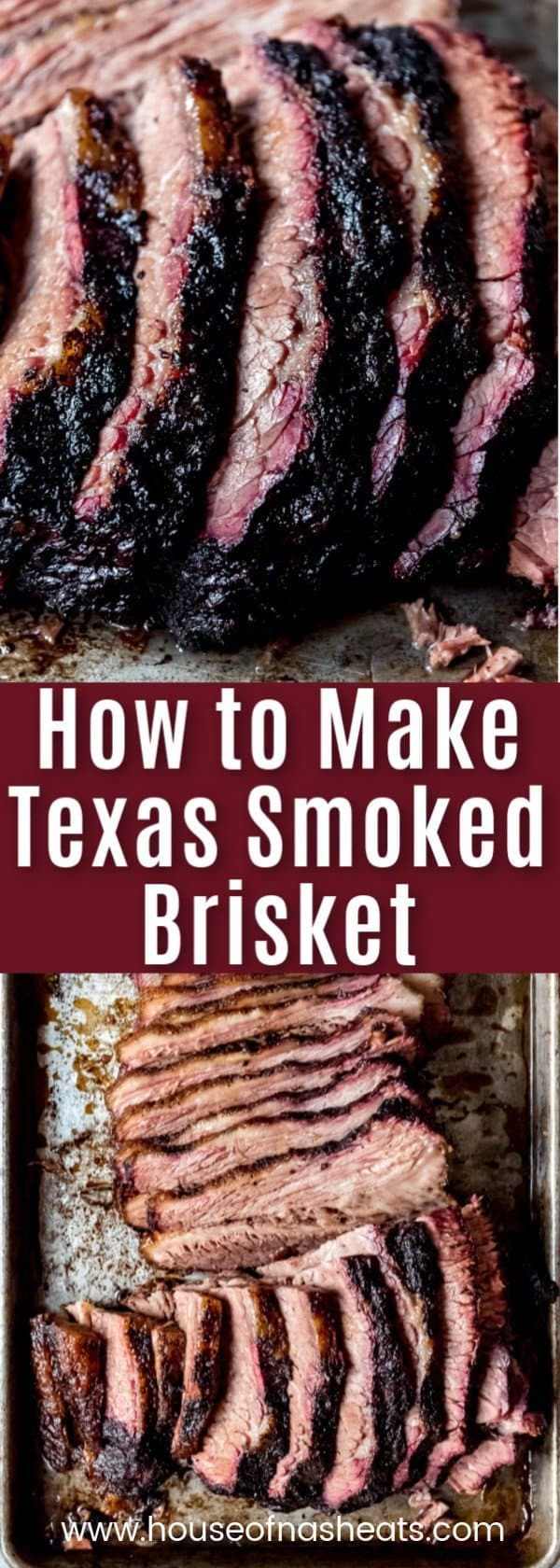


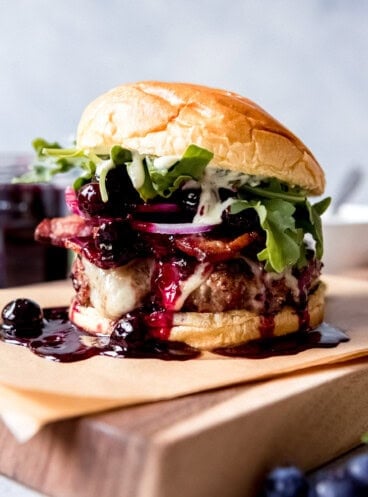

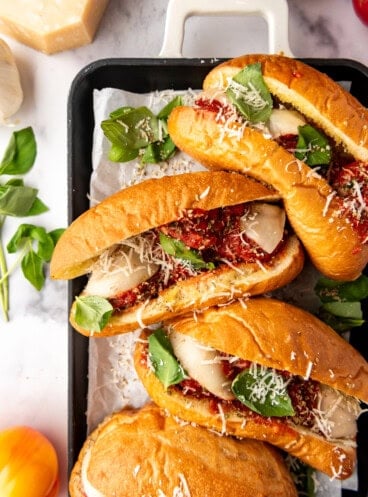




Oh wow! Look at that char and crust! I can almost taste the burnt ends! As soon as we move, I’m buying a smoker and making this! It looks amazing!
Drool-worthy! Delicious!
In your blog post you say to keep the smoker between 225-250 but in the recipe instructions at the bottom you say keep it at 275. Would you please clarify if you change your smoke temp at all between processes?
Thank you for catching that. We keep the smoker between 225 and 250. I made the correction in the recipe card!
How do you Reheat your brisket
I think it’s best to reheat in the oven at 350 for 15-20 minutes until hot.
Do you leave the water pan in the entire time or just the first few hours? My husband smoked a brisket last night & it seems to get tough shortly after he slices it. It had a nice bark & flavor though.
He didn’t use a water pan nor did he let the meat sit after taking it out of the fridge.
Yes, leave the water pan in the entire time. That’s strange that it gets tough after slicing. Do you know if the meat was frozen and then thawed? I find that it makes a difference sometimes using fresh meat that has never been frozen and I wonder if that could be a contributing factor.
Very simply explained. We fumble bumble this.
We will try this weekend. Thanks!
Excellent! Easy to understand. I grew up in Austin and Temple, eating Czech-Texas BBQ in my formative years. Now I get Kansas City BBQ after moving up here. It’s great but I miss the pecan smoke. I must say your recipe and instructions are outstanding! Even I can follow these. Thank you for your awesome photos, descriptions, and clarity.
Great read! I’ve been smoking Texas brisket for many years. The only suggestion I would change is in your sides recommendations. Instead of baked beans, we usually make a big pot of Texas pinto beans.
I got a pellet smoker last week and brisket was my first meat smoke (ambitious, I know!). I invited people over for dinner full well acknowledging we might need to go out to eat because I was nervous about smoking for the first time. Boy was I wrong! One of the people (a trained chef) said it was the best brisket he had EVER had!! It was so good, so juicy and tender and perfect!! It didn’t take as long as I thought (started at 5am, pulled it off the smoker at 2pm). I was nervous about the long rest period – it rested for 4 hours – but wow. It was amazing. Thank you for the detail in this recipe/tutorial!! I’ve already sent it to 4 other friends who are intimidated by the brisket. A note for others: I couldn’t find the packer cut so I went with an 11 lb point cut (9 lbs after trimming) and it was still amazing! Also, the rub sounds really simple, but don’t add anything to it! The biggest complement was the rub/flavor and people were shocked it was just salt, pepper, and garlic.
You’re comment absolutely made my day! This is exactly what I hoped would happen for people who tried this brisket recipe (and frankly any of my smoker recipes!) Congrats on your new purchase!
Hi there, I just finished reading all about your Smoked Brisket instructions and recipe. We do have a Traegar so we’re good with the actual smoker. We picked up today a 5.2 lb. brisket at the grocery store ( I know you said not to use grocery store cuts, but,we have it now ). My question is do cut not only the rub recipe in half and the cooking times for this size of brisket ?
Would it hurt to leave the brisket with seasoning on over night like 10 hours
Sorry in the fridge before smoking
Yep – in the fridge is the way to do it.
Not at all! We do this all the time.
I’m from Texas, but spent the last 27 years in Michigan. This was my first ever brisket and it was wonderful!! Thank you so much for this great, easy-to-do recipe/process!! ❤️❤️❤️
Great recipe. Easy instructions to follow. I got a Traeger this summer that I love. But, I’ve felt too intimidated to make a brisket until now. The only thing I had to change was to not use salt. We’re on a very low sodium diet. Ground black pepper and granulated garlic powder is my go-to rub for steaks. So, I figured I couldn’t go wrong. Your directions were so easy to follow, especially about when, why, and how to wrap. It came out perfect! Leftovers were enjoyed, too. Thanks for breaking it down real simple.
I’m happy to hear that you found the instructions helpful!
When placing the meat on the smoker, should it be removed from the baking sheet or place directly onto the grill rack of the smoker? Thanks!
Yes, place it directly on the grill rack for maximum smoke penetration.
Thank you! Can’t wait to try this one out!
You are welcome! I hope you do and let me know how it goes!
Hello, your recipe and the reviews it’s received sound delicious! However, we raise our own beef and ours is only 5lbs. Do you have any suggestions on cooking time for that size? Thanks!
If you have a smaller brisket you obviously won’t need to cook it for as long. I would go by the rule of thumb that brisket typically needs to cook for about 1 hour per pound of meat, plus an extra hour just to be sure. Then focus on getting the right temperature using a digital meat thermometer to know when it is done. I hope that helps!
This was the first time I’ve ever made brisket and the thought of making it was always intimidating. I followed your recipe exactly and I have to say that this was the best brisket I’ve ever had!
Thank you so much for taking the time and energy to perfect this brisket recipe and for sharing with all of us. I am more confident now and after a couple of weeks, I have a second one on the Traeger to serve to company!
I’m so glad to hear it!
Hi, I was wondering how you would store the brisket before serving. Perhaps I can wrap it in towels and stick it in a cooler? It would be 11 hours before we would eat.
Also, I have a 15 lb brisket so I would start this around 3:00pm, check it around 8 or 9 and wrap in foil. Go to sleep, smoke it for another 10 more hours so i would finish by 6:00am in the morning. Is that the only way anyone can time it so they can sleep?
Yes, we wrap ours in towels and keep it in the cooler. I haven’t tried doing it up to 11 hours ahead, but we have definitely done 4 hours and the brisket has been super hot and juicy when we go to slice it. And yes, we frequently smoke our brisket overnight, which many people might disagree with but a girl has gotta get her sleep!